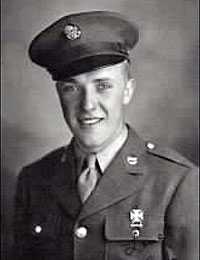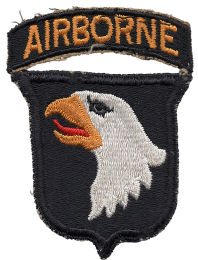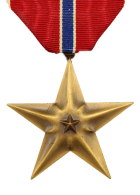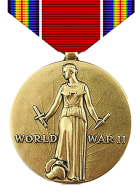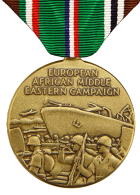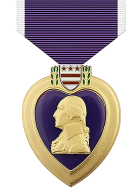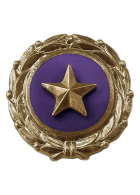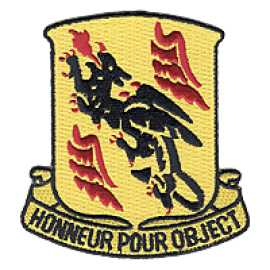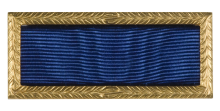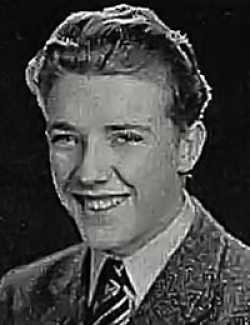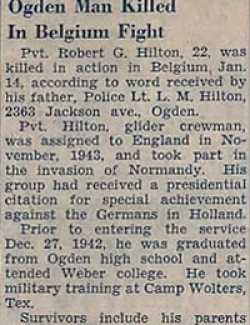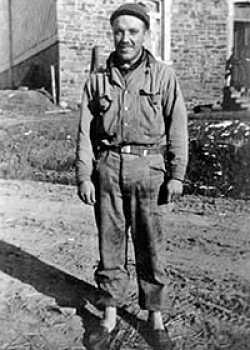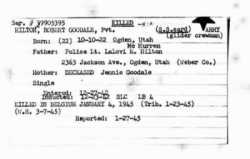Robert Goodale Hilton was born on October 10th, 1922 in Ogden, Utah of Weber County. His father was Lalovi (pronounced "Law-low-vee") McMurren Hilton, a Lieutenant (and later Chief) in the local police department, and his mother was Sarah Jane (Jennie or Jean, for short) Goodale Hilton. Robert also had a handful of siblings, respectively named Janet Hilton Hult, Lou Jean (Judy) Hilton Moss, Don Keith (Joe) Hilton, Joanne Hilton Brenner, Clifford Hilton, Marney Hilton Zambrano, and Laurence M (Tuff) Hilton, all of Weber County, Utah. The Hilton family were members of the LDS Church and very active in the Ogden community, working and contributing to both the church and police department for many years.
Just as Robert was graduating from Ogden High School in May of 1940, his mother Jennie tragically passed away, leaving behind her five children, Janet, Robert (Bob), Lou Jean (Judy), Don Keith (Joe) and Joanne. Robert's father Lalovi remarried in August 1941, before Robert entered any military service, to Mary Hodgson Hilton (Bob's stepmother) and they had three children, Clifford, Laurence (Tuff), and Marney. Regardless, the Hilton siblings still to this day refer to each other as "brother" and "sister" across the family.
After graduating from high school, Robert attended Weber College for some time before entering the military. At 19 years old, Robert was working for the US War Department at Hill Field in Ogden, UT, while also attending Weber College. He was then inducted into the US Army on December 23th, 1942, in Salt Lake City, Local Board 4. He underwent basic training at Camp Wolters, Texas in 1943. After completing basic training, he was assigned to B Battery of the newly activated 81st Anti-Aircraft/Anti-Tank Battalion, 101st Airborne Division, initially led by Lt. Col. Walter Scoggin.
Unit Context: The 81st AA/AT Battalion was made up of units from the 327 Glider Infantry Regiment (GIR) and the 401 GIR. In the late Summer of, 1942, the 81st AA/AT Battalion was activated at Camp Claiborne, Louisiana under command of Lt. Col. Scoggin. Company B of the 327th GIR became B Battery in the 81st, which Hilton would soon join. A, B, and C Batteries of the 81st would be anti-tank batteries. Each battery managed eight 37mm cannons, which were later changed for British 57mm heavy guns. These heavier guns still were transportable by glider (D, E, and F Batteries became anti-aircraft batteries).
In September of 1943, Pvt. Hilton’s unit deployed overseas to England, sailing on HMS Samaria with many other 101st men. They spent nearly 2 weeks at sea, taking turns sleeping on deck under the sky or sharing a bunk bed, stacked 5 bunks high in the lower decks of the ship. They landed in England, probably very happy to be off ship, having arrived in Liverpool.
The 81st settled at Basildon Park, near Reading, Berkshire, just west of London. Here they would train for the upcoming invasion of France some 7-8 months later. Pvt. Hilton was likely not a certified parachutist (5 qualified training jumps) as he was a glider crewman, but was most certainly qualified to blouse his jump boots (and for that $50 extra per month of Jump Pay).
On March 25, 1944, command of the 81st was transferred to Lt. Col X.B. Cox. Jr, who led the Battalion into its first combat situations on D-Day. “B” Battery and Pvt. Hilton’s commanding officer was Capt. Adolphe G. Gueymard; and Pvt. Hilton’s Platoon Leader was Lt. Robert "Joe" O'Connel. The 6 foot tall, 175lb Pvt Hilton known to have blonde hair and blue eyes was headed to soon face the enemy in one of the most crucial missions of the Normandy invasion - providing supplies and heavier weaponry to the Airborne forces already on the ground and paving a way off the beach for the seaborne forces.
On June 6th, 1944, Pvt. Hilton and the other men of A and B Batteries of the 81st took off from RAF Aldermaston, 10 miles southwest of Berkshire, England, as part of Mission Chicago. They were transported in a serial of 44 CG-4 Waco Gliders by a serial of C-47’s of the 434th Troop Carrier Group, with their intended release time for 0400 hours, on a landing zone between Sainte-Mère-Église and Sainte-Marie-du-Mont. The 81st Btn’s callsign in the division was “Kentucky,” and they wore a white triangle emblem on their helmets to distinguish themselves.
Pvt. Hilton was one of 155 personnel to land in gliders in Mission Chicago, and in one of 16 anti tank gun crews in the serial. Another notable man in the operation was Brigadier General Don Pratt. General Pratt was the assistant divisional commander of the 101st, and after helping to raise a new, combat-ready airborne division, became the highest ranking Allied officer killed in action on DDay. His glider failed to come to stop on the wet landing zone on the northwest outskirts of Hiesville, sliding and crashing into a hedgerow at high speed.
Pvt. Hilton most likely rode sitting next to his 57mm British anti-tank weapon in the belly of the wooden Waco glider, landing in a Norman field outside Hiesville just before the land invasion began. He was a gunner in his 4 man anti-tank gun crew, who sighted and fired the 57mm weapon.
The goal of Mission Chicago was to further reinforce the initial parachute landings that occurred hours prior. Pvt. Hilton may likely have experienced a dark and confusing glider landing, with the majority of the gliders in the serial losing sight of the lights prepared by pathfinders on the LZ, overshooting entirely. German fire was relatively ineffective on the landing, but many of the gliders crash landed in such a way that the equipment could not be immediately retrieved from the aircraft. Mission Chicago is historically considered a successful operation thanks to efforts of Pvt. Hilton and his unit. Batteries A and B of the 81st would later find out they received a Presidential Unit Citation for their actions in Normandy June 6th-11th.
Pvt. Hilton and B Battery fought thru their time on the line in Normandy, and eventually made their way back to the unit's base in England, at Basildon Park estate near Reading. On the morning of September 19th, 1944 (D plus 2), Pvt. Hilton and B Battery of the 81st were briefed at 1030am, and departed from Aldermaston Airfield at 1130. They were towed by Dakota C-47's across the English Channel once again. Each anti tank battery such as Pvt. Hilton's consisted of 23 Waco CG-4 Gliders in the serial. The weather was clear taking off, but upon reaching channel over Dover a fog closed in, and men reported not being able to see the tow plane from the glider.
The serial of gliders came in over Belgium and then turned North over the Netherlands, where Pvt. Hilton and B Battery landed in their glider on a farm field outside of the town of Zon, two days after the main parachute landings on the 17th. This was to be the beginning of Operation Market Garden for Pvt. Hilton, where he and the 81st would spend 41 days on the Main Line of Resistance (MLR, or "front line"). They landed around 1500 hours with very little flak but noteworthy amounts of small arms fire. Artillery and more small arms fire began falling on the Landing Zone (LZ) soon after landing.
Assembly of those glider crews that did land was efficient though, and the Battalion command post was set up just north of Zon in the afternoon of the 19th. Only 47 of the 81 gliders in the serial actually landed, many landing in Belgium, the English Channel, returning to England, and even a handful being lost in action.
Immediately after landing on Drop Zone W, Pvt. Hilton and his battery were in the process of assembling their guns, crews, and ammunition outside of Zon in the vicinity of the 101st divisional HQ. This is where General Maxwell Taylor, commanding officer of the 101st Division, was currently located with his staff. Hours after the glider landings on the 19th, Gen. Taylor's divisional HQ spotted a column of German armor approaching along the north side of Wilhelmina Canal dike, which was a narrow elevated road, only wide enough for single file column of armor (see gallery for map).
The column was led by either a Mark IV Panther or PZKW V Panther, and it was commanded by Lieutenant Major Berndt-Joachim Freiherr von Maltzahn of Panzer Brigade 107. He had recognized the Allied soldiers from his command post and set the tanks out to capture the bridge with reinforcements of panzer-grenadier infantry behind them. The divisional HQ was located in a schoolhouse on the Wilhemina Canal, and the German column of armor was approaching quickly with the building in their range.
The lead German tank fired an initial round into a British truck on the Zon bridge, sending soldiers jumping into the canal. It then fired another round at the schoolhouse building that housed divisional HQ. It is at this point that General Taylor himself mobilized a jeep and drove to landing zone W, where he came across Pvt. Hilton and his 57mm gun crew gearing up after the landing. General Taylor assembled Pvt. Hilton, his gun crew of 4 or 5 men, and the B Battery commanding officer, and they left the LZ together to stop the column of armor attempting to take the Zon bridge.
The time was now around 1700 hours, and General Taylor and B Battery Co instructed Pvt. Hilton and crew to set up between the schoolhouse and armor column. On their first shot they successfully knocked out a German Mark VI tank with their 57mm gun. The following tank in the column was then set aflame by bazooka squads of the paratroopers nearby. Having now lost their element of surprise, and finding themselves stuck on a one-lane road, not wide enough to turn around on, the German armor column requested infantry backup, which was denied due to late timing in the day. They were stopped cold and forced to retreat with multiple lost tanks, leaving the Allies in control of the Zon bridge.
It is said that right there on the spot General Taylor announced Pvt. Hilton and the other B Battery men from his squad would receive the Bronze Star for Valor. Pvt. Hilton's selfless actions under fire were directly witnessed and recognized by his divisional CO and every officer in between. In the following day, B Battery held the town of Zon and accounted for one armored car and one half track in another attack, providing key security for battalion and division command posts.
Pvt. Hilton and his battery were then attached to the 501st PIR, and moved into the town of Veghel, a few kilometers north of Zon. Within minutes of arriving into into Veghel, the 81st found themselves in the middle of their next oncoming armored attack, which they again successfully repulsed. B Battery accounted for another German Mark V tank.
In the following days they knocked out another two half tracks, bringing Pvt. Hilton's unit's total to one German Mk. VI tank, one Mk. V tank, three half tracks, and one armored car, all in the first four days on the line (Sept 19th-Sept 23rd). This action pushed the front line forward and allowed Battalion command to move further up "Hell's highway" toward the main campaign objective.
B Battery spent some time attached to the 506th PIR before being moved over to "the Island" - an area south of Arnhem and the lower Rhine and north of the Waal River and city of Nijmegen. The 81st and Pvt. Hilton would be in the Netherlands for a total of 72 days before being was transported back to Mourmelon, France in November 1944, where they trained and lived in an old army barracks for outfitting and recuperation.
The German westward offensive in the Ardennes Forest soon began on December 16th, 1944, and the 101st was sent not by plane or glider, but by truck to defend the vital crossroads town of Bastogne, Belgium. They drove northeast overnight in the large trucks of the Redball Express, breaking light restrictions to reach their destination as soon as possible. This was the beginning of the Battle of the Bulge for the 101st Airborne.
The 81st AA/AT Battalion was attached to the 501st PIR for movement into the Bastogne, Belgium region. Pvt. Hilton was on the road from Mourmelon, France to Bastogne on late on December 18, 1944, with other units of the 501st. B Battery of the 81st was just behind 1st Battalion, 501st in the motor column to Bastogne. They arrived on the northwest outskirts of Bastogne early in the day on December 19th, between Mande St. Etienne and Bastogne itself. Temperatures were already hovering around freezing, and sleet or frozen rain remained constant.
On Dec 20th, B Battery and Pvt. Hilton would move across Bastogne, to the north east, where they dug in around Mardasson Hill outside the city. The coming two weeks would see bitter fighting and even worse weather, with temperatures dropping well below freezing for the majority of the time spent on the line.
In the town outskirts and nearby Bois Jacques woods, where the only cover from shelling, exploding trees fragments, and small arms fire was a frozen foxhole or slit trench, the ground was iced solid throughout the day and night. This made digging that much more challenging for the men. Bastogne was soon surrounded by the Germans and under siege from all directions. Weather conditions prevented any Allied air support until Christmas. The 101st still persevered however and held their lines around Bastogne. They were paratroopers; they're supposed to be surrounded anyway.
By January 3, 1945, Pvt. Hilton and B Battery were again attached to the 501st PIR, where they were sent north/north east on the attack directly between the Foy and Bizory roads. They were sent to relieve 2nd Battalion, 506th on the newly advanced MLR in the south eastern portion of the Bois Jacques woods, directly north of Bizory.
As the 501st was advancing out of the cover of the forest, their flank was exposed and they were forced to pull back into the Bois Jacques, where Pvt. Hilton would have dug in his 57mm AT gun on the edge of the woods, with nothing but a foggy snow field in front of them. On January 4th, the Germans attempted cutting the salient the 501st and 81st had driven out into their lines. It was in this attack in the Bois Jacques that we speculate Pvt. Hilton was killed, possibly by either an 88mm shell or tank round while manning his gun. His actions were a true step in delaying the final German offensive on Bastogne during the Battle of the Bulge.
Pvt. Hilton’s Battery was instrumental in stopping German armored and infantry advances on Bastogne, causing formidable losses and delays for the German units. This action was key in holding the perimeter of the city long enough for a corridor to be opened in the besieged road hub. The 101st would become the first division in the US Army to receive a divisional Presidential Unit Citation for their defense of Bastogne crossroads. Pvt. Hilton also was awarded a Purple Heart.
He is buried at the Luxembourg American Cemetery and Memorial in Hamm, Canton de Luxembourg, Luxembourg. He rests in Plot H, Row 7, Grave 14.
We will remember him
A particular special thank you must be said to Laurence "Tuff" Hilton for providing a wealth of detail on the Hilton family genealogy and details on B Battery of the 81st AA/AT Battalion during the war.
